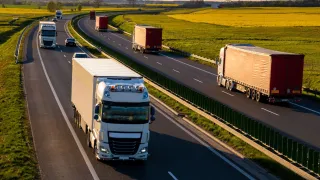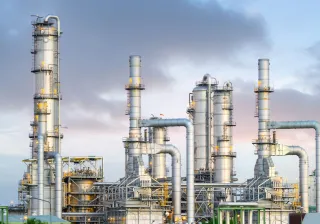Carbon dioxide can be used as raw material in producing chemicals, materials and transport fuels. Hydrogen is another key element, which can store energy produced from renewable electricity. When and how will this wonderful equation become a reality? Answers are being offered by VTT Research Professor Juha Lehtonen, and Senior Scientist Janne Kärki.
Trees and other growing plants trap carbon dioxide naturally, but it can also be sequestered either from emission sources of factories, or even directly from the air. If sequestered carbon dioxide is stored, this is called Carbon Capture and Storage, or CCS. If the carbon dioxide is used as a raw material, it is called Carbon Capture and Utilization, or CCU. The second main raw material in this is typically hydrogen.
1. What can be produced sustainably using carbon dioxide and hydrogen?
Carbon dioxide and hydrogen can be used to produce for example organic chemicals that can replace fossil oil in the production of plastics and fuels. Hydrogen is usually produced from natural gas, but it can also be produced sustainably through electrolysis – by using renewable electrical energy to split water into hydrogen and oxygen. When the topic is examined from the viewpoint of renewable energy, the expression Power-to-X runs alongside CCU.
2. Why produce transport fuel? Why not just electrify all transport?
In global estimates, no significant reduction in the need for energy for transport is expected before 2050, and then it will be possible to handle about 30 percent of the energy need through direct electrification of transport. Especially heavy road traffic and aviation and shipping will continue to require liquid and gaseous fuels. Biofuels are a good option, but their supply is limited. Hydrogen, meanwhile, requires considerable changes in fuel distribution and engine technology. However, if hydrogen and carbon dioxide are used in the production of liquid fuels, such as diesel, they will fit into the existing infrastructure. These kinds of fuels are called electric fuels, or e-fuels.
3. Why would it make sense to produce chemicals and materials using carbon dioxide, in addition to fuels?
Carbon dioxide can be trapped for decades if it is used in chemicals, which can be used as raw materials for the manufacture of durable materials. Together with our partners we have produced, for example, raw materials for the manufacture of polyurethane, which can be used as a building insulator and in adhesives. Nova-Institute in Germany has concluded that in 2050 carbon dioxide could be used for producing more than 300 million tons of plastics and other polymers annually. This is almost the same as the amount of plastics produced out of fossil-based raw materials today.
4. What is the focus of VTT in the research?
At VTT we study and develop the entire value chain that is needed for the utilisation of carbon dioxide and hydrogen in products and fuels. Our points of view are both Power-to-X and CCU. We are knowledgeable about energy and hydrogen systems and we are developing technologies for different process steps including e.g. electrolysis and carbon dioxide sequestration and conversion. We also have lengthy experience in the development of process concepts and in scaling them to production. In addition, we also utilise our engine laboratory in the development of fuels.
5. How can VTT demonstrate the entire production chain?
We have mobile units about the size of sea containers for carbon dioxide sequestration, production of hydrogen through electrolysis, and the conversion of carbon dioxide and hydrogen into different kinds of products. For example, we can take these containers to industrial sites that emit carbon dioxide.
6. How’s the global hydrogen business outlook?
Hydrogen has long been a topic of discussion, and it is the focus of tremendous interest around the world. Nevertheless, the production of hydrogen continues to be dominated by steam reforming, a method for extracting hydrogen out of natural gas. This is how it is done both in Finland and around the world. However, in recent years we have achieved rapid growth in investments into electrolysis, and now news of huge investments are coming around the world, including Europe.
7. How’s Finland's hydrogen road map on the way to 2030?
Before 2030 hydrogen will probably be used as such in various industrial processes, and only after 2030 will e-fuels or e-chemicals be utilised more broadly. The latter phase will also probably be when SSAB shifts to hydrogen reduction at its steel mill. This will double the current demand for hydrogen in Finland. Interest in the building of value chains around hydrogen is already considerable. For example, 30 Finnish companies set up a national hydrogen cluster in February 2021 to promote the hydrogen economy.
8. Can the production of green hydrogen be profitable in Finland?
The green production of hydrogen could start immediately with small portable electrolysers. More extensive production depends largely on the development of the price and production technology of electrolysis and the availability of affordable electricity. In Finland, the price of electricity is reasonably competitive and waste heat produced by electrolysis could be utilised in heating or in industrial processes. Oxygen produced in electrolysis could also be used in the pulp industry, for example. Electrolysis technology has also been developed in Finland in an increasingly efficient direction. Efficient solid oxide electrolysis, in whose development VTT has taken part, could offer business opportunities for Finnish companies.
9. What is the E-fuel research project?
In the E-fuel research project, integration of hydrogen produced by high-temperature electrolysis (SOEC), carbon dioxide sequestration, and Fischer-Tropsch fuel synthesis are being developed with the aim of achieving a breakthrough for Finnish technology in the growing market for synthetic fuels. Fourteen companies are taking part in the project, which is coordinated by VTT. The project budget is 3.3 million euros with main funding from Business Finland, and Andritz, Convion, Elcogen and Neste are participating in it with their own research projects. This involves a combined investment of more than six million euros in the development of the production of e-fuels. The project, coordinated by VTT, is part of Veturi ecosystem funding from Neste. VTT also has many other projects in the different areas of P2X.







